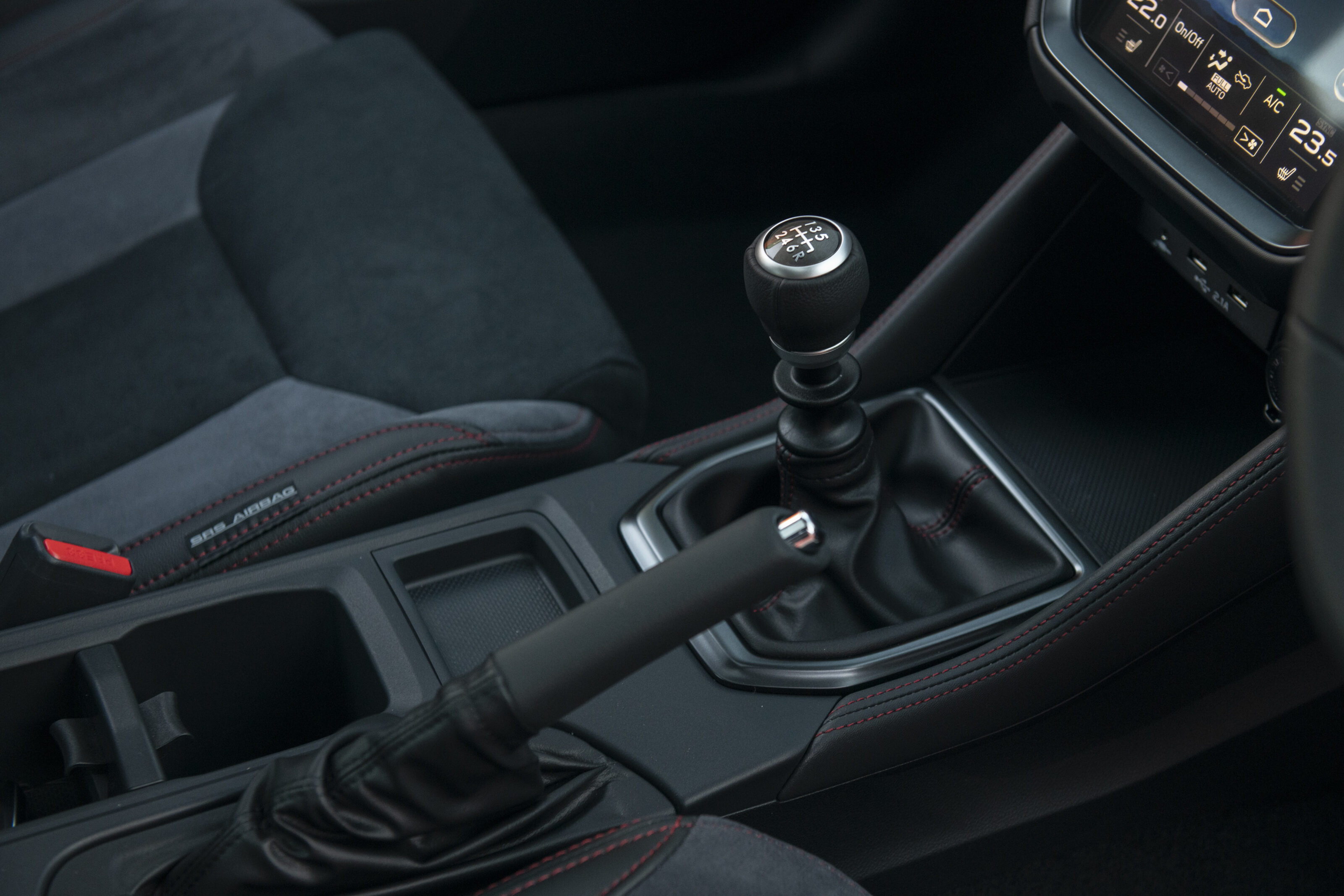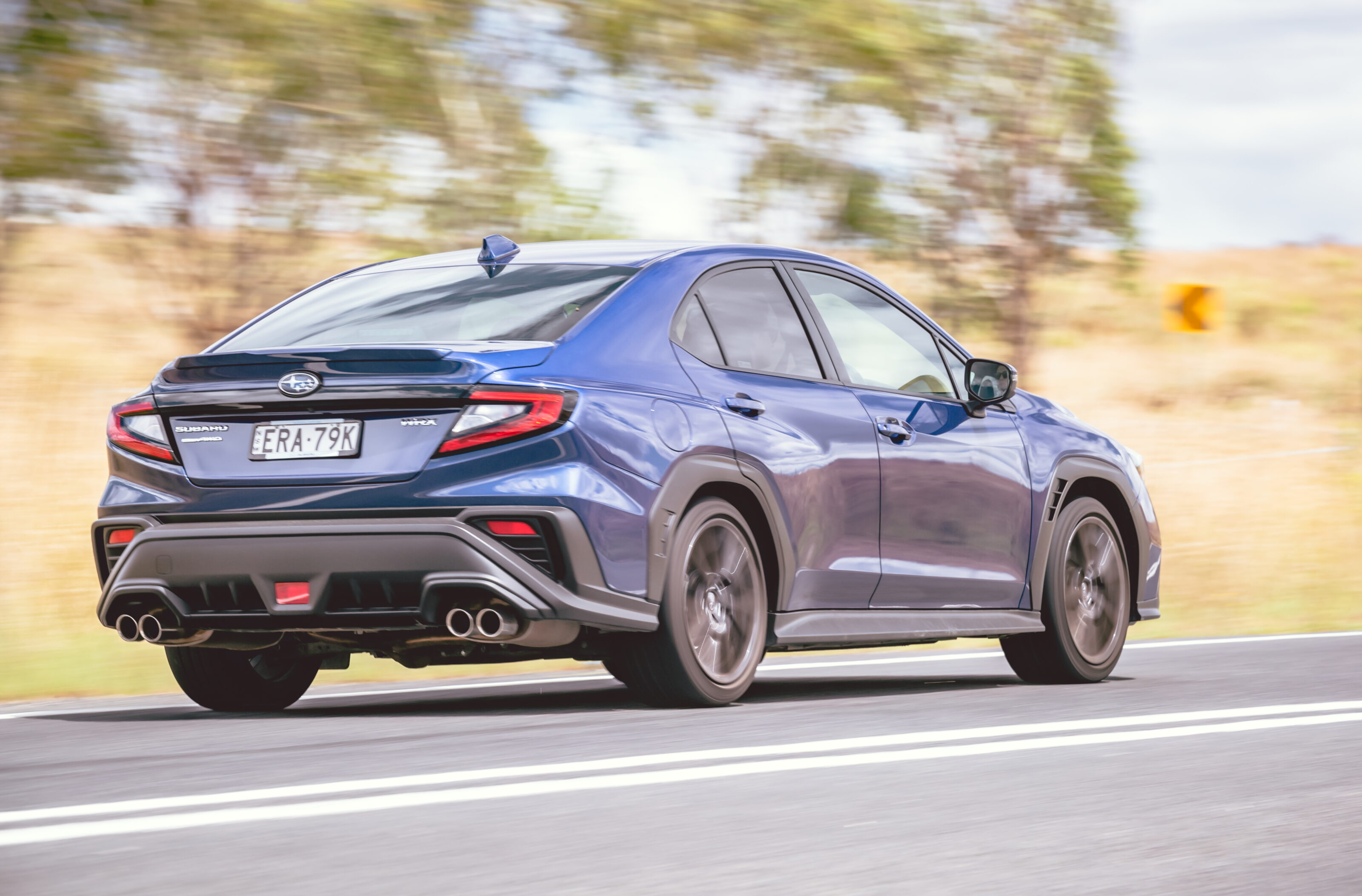Score breakdown
Things we like
- Pointy handling
- Smooth boxer engine
- Generous portrait touchscreen
- Knuckly gearshift
Not so much
- Agitated ride
- No AEB or RCTA
- Thick, unshapely steering wheel
- Unexciting power delivery
The WRX’s nose eagerly hooks into a dusty, off-camber third-gear bend, tracing the line markings with ease as the rear pivots gracefully around under a trailing brake. It’s all agility and balance.
But this is a rare case in Subaru’s latest WRX. The latest-gen model debuted in May 2022, based on the Subaru Global Platform and with a new 2.4-litre turbo-petrol flat-four (now also found in the Outback XT) under the bonnet. There are three trims in the WRX sedan line-up, and with no STI coming, this RS manual is the most hardcore you can get.
It’s stacked with features for the price – including a near 12-inch touchscreen – and rides on a different spring and damper tune to the base ‘VB’ Rexy. It should be the driver’s WRX, and it is, but that comes with a host of compromises that leave us… a little confused.

JUMP AHEAD
- How much is it, and what do you get?
- How do rivals compare on value?
- Interior comfort, space and storage
- What is it like to drive?
- How much fuel does it use?
- How safe is it?
- Warranty and running costs
- VERDICT
- Specifications
How much is it, and what do you get?
Smack bang in the middle of the range, the RS looks pretty decent value at $50,490 before on-road costs, and it isn’t like Subie’s skimped on kit.
The RS gets power-adjustable seats, satellite navigation and a Harman Kardon sound system over the manual-only base car. There aren’t any options; the sunroof is standard, as is metallic paint.
| Subaru WRX RS features | |
|---|---|
| 10-speaker Harman Kardon sound system | Dual-zone climate control |
| 11.6-inch touchscreen | Seat heating |
| 18-inch alloy wheels | TomTom sat-nav |
| 8-way power seats | Tyre pressure monitoring |
| Active LED headlights | Wired Android Auto |
| Auto-dimming rear-view mirror | Wired Apple CarPlay |

How do rivals compare on value?
In a space that was once chock-a-block with rivals, most manufacturers have abandoned the all-wheel drive performance sedan in favour of boosted SUVs like the Volkswagen Tiguan 162TSI R-Line ($57,790 before on-road costs).
An Audi S3 ($73,900 before on-road costs) is smaller and a lot dearer; closer in price is a GR Yaris but that three-door’s minuscule boot ain’t up to family duties.
A GR Corolla ($62,300 before on-road costs) or Skoda Octavia RS ($55,990 drive-away) are closest in ethos and space to the Rex, and each comes equipped with more standard safety kit than this manual RS, which misses out on potentially life-saving auto emergency braking and lane-trace assist tech.

Interior comfort, space and storage
While it’s an improvement on GD and GC series Imprezas, the VB WRX’s cabin isn’t what you’d call premium.
Primary materials such as the soft armrest and high-qual suedecloth upholstery feel good but then you notice the dash is capped in scratchy plastic.
The steering wheel is also bulbous and awkward to hold, not aided by rough leather wrapping – the tiller has none of the appeal that an early Impreza WRX’s svelte Momo rim did. Speaking of controls, the gear stick is a long way away and the high-set driver’s seat feels more SUV (guess that suits the dimpled black cladding outside?) than sports sedan.
At least the technology package is pretty stellar, the WRX’s 11.6-inch touchscreen is very generous in size, and its portrait orientation will feel natural to smartphone natives. It’s responsive, and the HVAC controls persist at the bottom of the screen for easy interaction.

The 10-speaker Harman Kardon sound system does a solid job of rendering tunes, but the Rexy’s instruments feel old hat next to Skoda and Toyota’s digital driver’s displays, and there’s no head-up display, either.
Cabin storage accommodates two slim drink bottles in the centre console and a further two in the doors. There’s no USB-C connectivity, so it’s up to an awkwardly-placed USB-A port for wired smartphone mirroring that seems at odds with the impressive screen above.
The rear seat is generous for six-footers with good under-thigh support, a fold-out armrest with two cup holders, and two USB-A charge points. There’s a great view, too, out thanks to the raised bench, but oddly manual versions don’t get adjustable air vents – that’s for automatic variants only.
Sure, the power tailgate of an equivalently-priced wagon or soft-roader makes it easier to stuff bikes and flatpack furniture into, but at 411L the Subaru’s boot is still very useful. A full-size spare is located beneath the boot floor in typical Subaru fashion.

What is it like to drive?
When you and the WRX are committed to a twisty road it’s an engaged and agile dance partner, but as a package, it’s let down by a powertrain that doesn’t have the urgency or talent the chassis is looking for.
The 2.4-litre boxer produces its 350Nm from right down low, (2000-5200rpm), so it feels peppy in the mid-range, but just as you’re getting to indulge in second gear’s grunt the redline abruptly ends proceedings at just 6000rpm.
As tractable, smooth, and punchy as the ‘FA24F’ may be – it even approaches muted aural pleasure – it’s a motor designed to mesh with the car’s continuously variable transmission (CVT), rather than the knuckly but satisfying long-throw six-speed manual.

You can’t help but feel that this RS in particular is having a little bit of an identity crisis.
And that’s okay in the more sedate base WRX, or the dearer tS with its adaptive dampers that give the sedan much greater bandwidth, but the RS’s stiffer springs and 18-inch alloys shod in 245/40 R18 Dunlop Sport Maxx rubber equate to an edgier ride quality with a tendency to buck and jiggle over expansion joints and potholes in town – a feeling amplified as you watch the bonnet scoop shimmy over bumps.
Bring the car up to speed and the tight body motion feels better. Throw the WRX down a testing, slippery road, and its symmetrical all-wheel-drive security is complemented by a pointy front end and agile rear that allow you to exploit this sedan with confidence.
The steering is light and vague, but it is accurate. Learn to trust its sharp initial reaction and the WRX RS comes alive. Owing to its low redline the gears feel short like a WRC car’s and, in isolation, the RS can be a really enjoyable car to punt – providing you learn to trust its wooden brake feel.
You can’t help but feel that this RS in particular is having a little bit of an identity crisis. The focus of the chassis politely requests an engine that revs to 7500rpm, has a louder exhaust and spikier power delivery to bring it alive. For this reason, the more sophisticatedly-damped tS remains our pick… but you can’t have it with a manual.

How much fuel does it use?
The WRX’s new engine requires 95 RON premium unleaded at a minimum, and its fuel consumption is rated at 9.9L/100km in the ADR combined cycle.
Our testing saw the WRX read a much higher 13.5L/100km on its trip computer, though brim-filling the tank revealed an 11.8L/100km figure on a twisty test loop.

How safe is it?
The manual transmission doesn’t interface well with Subaru’s Eyesight safety suite. It’s a similar story to the BRZ/GR86 twins, though Subaru offers a sizeable discount ($4000) for the manual WRX.
Although most driving enthusiasts would disable the lane-keep assist, a total lack of AEB isn’t great in this day and age. Backing up the safety issues, the latest WRX has not been evaluated by independent safety testing body ANCAP.
It’s confounding that Toyota and Hyundai both manage to package the potentially life-saving tech into GR Corolla and i30 Sedan N rivals where Subaru can’t. Both of those rivals allow drivers to easily disable the tech on track, too.

| 2023 Subaru WRX RS manual safety features | |
|---|---|
| Blind-spot monitoring | Rear cross-traffic alert |
| Driver attention monitoring | Auto high beam |
| Front camera | 8 SRS airbags |

Warranty and running costs
Subaru mandates servicing every 12 months or 15,000km. Five years or 75,000km of WRX maintenance will cost $2433.06.
The WRX is covered by a five-year, unlimited-kilometre warranty like all Subaru products in Australia.

VERDICT
There’s a great car in the latest WRX, but the RS’s unsettled urban ride quality isn’t backed up by the sort of firecracker engine or feeling of specialness that Subaru’s rumbly and peaky ‘EJ’ engines served up.
If you’re looking for chassis focus combined with drivetrain sparkle and aren’t worried about a plush urban ride, then the Hyundai i30 Sedan N and Toyota GR Corolla offer more engaging packages.
This leaves the WRX RS feeling a little confused. It hurts to hit these next three keys as our recommendation, but truthfully, the CVT-equipped tS is a safer and more well-rounded package.
Better still, the WRX tS Sportswagon channels the sort of fluid handling and ride quality of Subaru’s excellent fourth-gen Liberty GT, so if it’s brisk family transport you’re after, that’s the WRX we’d recommend.
| Subaru WRX RS manual specifications | |
|---|---|
| Price | $50,490 + on-road costs |
| Drivetrain | |
| Engine | 4cyl, horizontally opposed, 2.4-litre, DOHC direct injection turbo-petrol |
| Layout | Front engine, AWD |
| Power | 202kW @ 5600rpm |
| Torque | 350Nm @ 2000-5200rpm |
| Gearbox | 6-speed manual |
| Chassis | |
| Body | 4-door, 5-seat small sedan |
| L/W/H/Wu2013B | 4670/1825/1465/2675mm |
| Track (F/R) | 1560/1570mm |
| Weight (tare) | 1516kg |
| Boot | 411L |
| Fuel/tank | 95 RON / 63 litres |
| Economy (combined ADR81/02) | 9.9L/100km |
| Suspension | Front: struts, coil springs, stabiliser bar. Rear: double wishbone, stabiliser bar |
| Steering | electric rack-and-pinion, 2.4 turns lock-lock |
| Front brakes | ventilated discs |
| Rear brakes | ventilated discs |
| Tyres | Dunlop SP Sport Maxx |
| Tyre size | 245/40R18 |
| Safety | |
| ANCAP rating | unrated |
| 0-100km/h | 6.2 seconds (estimated) |
Score breakdown
Things we like
- Pointy handling
- Smooth boxer engine
- Generous portrait touchscreen
- Knuckly gearshift
Not so much
- Agitated ride
- No AEB or RCTA
- Thick, unshapely steering wheel
- Unexciting power delivery
We recommend
-
 News
News2022 Subaru WRX pricing and features
Pricing and equipment for the new 2022 WRX sedan and wagon have been announced as the vehicle goes on sale in Australia
-
 Reviews
ReviewsLiving with the new Subaru WRX Sportswagon tS: Long-term test
The Levorg is dead, long live the Subaru WRX Sportswagon – and any wagon brave enough to compete in our SUV-mad market. We're spending a few months with the new Subie to see if it's right for fun and family life alike
-
 News
News2025 New Car Calendar: All the new cars coming to Australia
Take a look at our list of what is expected to launch in Australia in 2025 – plus those we might not see locally just yet






